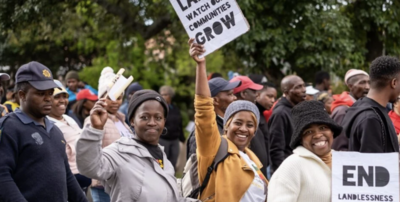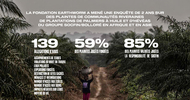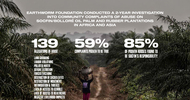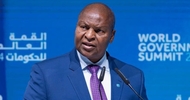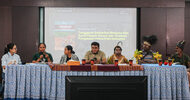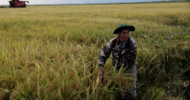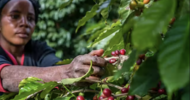 Women working on a farm in Souk Sebt municipality, Jendouba delegation, Jendouba, Tunisia. (Photo: Alessandra Bajec)GIS Reports | 14 April 2025
Women working on a farm in Souk Sebt municipality, Jendouba delegation, Jendouba, Tunisia. (Photo: Alessandra Bajec)GIS Reports | 14 April 2025The growing competition for Africa’s agricultural land
by Teresa Nogueira Pinto
Global demand for arable land is rising, making Africa a key target for large-scale acquisitions to tackle food and energy challenges.
The global race for fertile land has intensified in recent decades, resulting in a surge of large-scale land acquisitions (LSLAs). These transactions include purchases, long-term leases or concessions over 200 hectares by foreign entities for agricultural or other purposes.
In developed nations, urbanization and efforts to cut greenhouse gas emissions have reduced the amount of land available for livestock and agricultural production. Emerging economies face growing food demand, including for animal products, spurred by population growth and socioeconomic shifts. The push for renewable energy, especially biofuels, has further increased competition for land and water resources.
The 2007-2008 global food crisis played a crucial role in increasing the emergence of LSLAs, particularly due to the perceived political fallout in the Middle East and North Africa. Rising food prices fueled unrest in the runup to the Arab Spring, with many linking the upheaval to basic “bread and butter” issues like food security and employment. This instability underscored the vulnerabilities of food-importing nations with scarce agricultural resources, exposing them to market volatility.
The ripple effects of internal conflicts in Libya and Syria amplified these concerns beyond their borders. In response, Gulf states like Saudi Arabia and the United Arab Emirates pursued food security strategies, securing land and water abroad through large-scale land acquisitions in regions such as Southeast Asia, Eastern Europe and other parts of Africa.
Following the global financial crisis of 2007-2008 and amid rising demand for food and energy, tangible assets – especially arable land – became increasingly appealing to investment funds looking to diversify their portfolio beyond traditional financial holdings.
More recently, the Covid-19 pandemic, the surge in protectionism and escalating conflicts in key geopolitical and geoeconomic regions have reshaped global value chains and further intensified unease over food and energy security.
Africa’s central role in global land investments
Africa occupies a pivotal position in the global agricultural investment landscape, as evidenced by data from the Land Matrix Initiative. According to this data, 37 percent of global large-scale agricultural investments occur in Africa. This prominence comes as no surprise, given Africa’s vast agricultural potential. As noted in a previous GIS report, the continent is home to 65 percent of the world’s uncultivated arable land. Also, many African governments are keen on land agreements, especially long-term leases, which help them navigate the complexities surrounding communal land ownership.
These large-scale land deals offer significant opportunities, potentially serving as a catalyst for an African Green Revolution akin to the transformation witnessed in South Asia during the 1960s. Driven by increasing use of high-yield crops, fertilizers and irrigation, countries like India shifted from food scarcity to self-sufficiency. A framework promoting capital investment and technology transfer in Africa today could similarly boost agricultural productivity.
Despite some progress, several challenges persist. Data indicates that slightly more than 50 percent of finalized deals are operational; that is, the land leased is actually being used for something, though not necessarily farming. Actual farming is taking place on only 11 percent of the contracted land. In some countries like Mozambique and Tanzania, large tracts have been allocated to produce biofuels or agro-industrial crops. Unfortunately, these initiatives do not improve food security.
Bioethanol production gained traction in the late 2000s, fueled by assumptions that oil production had peaked and amid strong pressures and incentives for decarbonization. This momentum, however, has weakened over the past decade due to growing concerns over the sustainability of biofuels, their carbon footprint, effectiveness in ensuring energy security and impact on food supply. The rapid expansion of electric vehicles has further contributed to the decline in bioethanol’s prominence.
In recent years, another key driver of land deals has emerged: the growth of carbon markets, which often involve the appropriation and management of land and ecosystems. As outlined by the Voluntary Carbon Markets established in the Kyoto Protocol, carbon credits have become a valuable commodity that can be traded. Buyers are usually companies and countries aiming to comply with regulatory requirements. Sellers include regulatory bodies, project developers working to reduce or remove carbon dioxide from the atmosphere, and nations – many in Africa – that have accumulated carbon credits due to their low emissions.
In 2022, African countries launched the African Carbon Markets Initiative during the United Nations Climate Change Conference, also known as COP27. Gabon, known for its forestry resources, became the first nation to make carbon credits available through a mechanism under the UN Framework Convention on Climate Change. Kenyan President William Ruto referred to carbon resources as an “unparalleled economic goldmine.”
Geopolitical effects of large-scale land acquisitions
Land deals, especially through leases, have become more prominent in the past few decades. Although they have not fundamentally transformed African agriculture, their trajectory reflects the influence of the shocks and structural shifts that have shaped global geopolitical dynamics over the past 20 years.
This underscores the growing worries of major global powers and emerging economies, including China, India, Turkey and Gulf countries, as they strive to secure access to food supplies. It is also important to note that European and American investment funds have moved into such deals, as seen in cases like Tanzania and Ghana. Current trends also reflect how African governments, from Ethiopia and Mozambique to Madagascar, Sudan and Gabon, are working to secure financing in the wake of commodity shocks and, more recently, the gradual reduction of foreign aid.
Investments are also shaped by historical and geopolitical connections. For instance, Sudan has forged agreements with Gulf nations, while Brazil has invested in biofuel production in Mozambique.
Moscow has been expanding its footprint in Africa, with visible effects, particularly providing security services to regimes in the Sahel region, but it has not significantly engaged in land deals or investment. To the contrary, Russia is now Africa’s main grain supplier. Given that it is the world’s largest country by landmass, possesses vast agricultural expanses and has a low population density, Russia lacks incentives to outsource agricultural production.
Moreover, Russian investors targeted by sanctions find little advantage in leasing land within voluntary carbon market mechanisms. Instead, Russia has primarily focused on strengthening its military presence on the continent by negotiating the establishment of military bases in Sudan and the Central African Republic. It has also pursued access to valuable mineral resources through deals that involve providing arms and security services to regimes across the Sahel region.
Some African governments have tried to expand their control over agricultural land, especially in disputed territories. This is evident in the Al Fashaga region, where Sudan and Ethiopia vie for dominance over sesame production and trade.
Diverging perspectives
LSLAs have ignited a heated and politicized debate, with critics denouncing the practice as “land grabs” and instruments of “neocolonial exploitation” or “green colonialism.” Other critics emphasize that some investors, particularly governments, acquire land not for commercial purposes but to secure food supply for their own countries. In these cases, investors acquire land in food-insecure countries for agricultural production. However, instead of supplying local, national or regional markets – where it could enhance food availability – the produce is exported to other regions, such as the Gulf states.
In fact, some countries where these deals have occurred, such as Mozambique, Sudan, Chad and Tanzania, show high levels of food insecurity for local populations. The challenge is compounded by the current global context, characterized by the erosion of free trade and the fragmentation of supply chains in international trade, which may exacerbate local vulnerabilities.
The difficulty in obtaining accurate data across Africa highlights a broader lack of transparency that raises the risk of corruption. Furthermore, by implementing non-financial standards to evaluate economic performance, major initiatives such as carbon credits could adversely affect the agriculture and forestry sectors, heightening the chances of corruption or greenwashing.
Recently, African forests have drawn significant interest from companies operating in the burgeoning carbon credit sector. Some of these land deals occur in challenging business environments marked by territorial disputes, armed conflict and political instability, as seen in the Democratic Republic of the Congo.
While the risks warrant careful consideration, such critiques often overlook the role and agency of African governments. These governments voluntarily participate in these deals by, for instance, publicly offering land to prospective investors. Although navigating difficulties in regions where land use and tenure are often sensitive and complex issues, large-scale land acquisitions could be essential for the transformation of Africa’s agricultural sectors. Given the vast expanses of underutilized land across the continent, attracting large-scale investments will be vital to improving efficiency, advancing technological capabilities and enhancing connectivity.
Scenarios
Most likely: Global large-scale land acquisitions to continue in Africa
In a likely scenario, African land will continue to attract interest from investors and governments. However, the frequency and nature of these deals will differ from those observed following the 2007-2008 financial and food crises. Specifically, the structure and geographic distribution of the deals will reflect the consolidation of emerging geopolitical alignments, including the growing influence of Gulf countries in some African regions.
Concerns about self-sufficiency and control over production chains will remain dominant, overshadowing the free trade principles that characterized the 1990s and early 2000s. Additionally, while momentum behind environmental, social and governance considerations may be waning, carbon credits will continue to provide a framework for investment in some regions. For instance, the African Carbon Markets Initiative seeks to generate 300 million new carbon credits annually through 2030.
This new context, combined with food insecurity and political instability in several African countries, reduces the prospects for win-win solutions – deals that fulfill the interests of investors while promoting the development of agricultural production and food markets across the continent. This does not mean mutually advantageous deals cannot occur. Countries with fertile land and water, supported by political stability, strong land rights frameworks and deeper integration into regional value chains, are better positioned to capitalize on such opportunities.
Less likely: The rise of Africa’s Green Revolution
Considering the prevailing investment drivers as well as geopolitical and geoeconomic trends, a wave of land and agricultural investments sparking a Green Revolution in Africa seems unlikely in the short to medium term. While significant investment is crucial to unlocking the potential of agriculture in Africa, this scenario may reveal differing, and at times irreconcilable, perspectives on land tenure and use across the continent. In certain regions, like the Horn of Africa and Central Africa, these differences could lead to political tensions and clashes among local communities.


